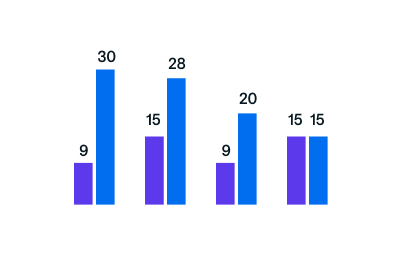Life Sciences Learning
Strategic training for medical affairs, pharma sales, and life sciences teams

Training That Empowers Teams
MEDICAL AFFAIRS • PHARMA SALES • LIFE SCIENCES
At Amplity, we deliver targeted training that elevates the performance of medical affairs departments, medical science liaisons (MSLs), life science leaders, and pharma sales teams.
We fortify our learning program with a degree of life science and pharma knowledge that no other firm can match. Our experts aren’t only versed in the art and science of medicine – they are genuine degree-holding professionals with medical affairs and life sciences leadership experience.
Whether you’re launching a new product, onboarding a field medical team, evolving your medical affairs strategy, or coaching new leaders for success, our expert-led training ensures your teams are aligned, empowered, and ready to drive results.
Welcome to Amplity Learn.
Medical Affairs Training
Experts in medical affairs, our training transforms your teams into flexible strategic partners, capable of working across the enterprise to launch innovative therapies.
We are especially adept at training medical science liaisons so they can confidently and compliantly gather insights and share scientific data. Pioneers of the scientific engagement model, we teach all aspects of effective field medical engagement. Authentic relationships lie at the heart of our work. Our KOL engagement courses instill active listening, trust-building, empathy, scientific storytelling, and presenting with impact, so your MSLs build relationships that last.
Pharma Sales Training
Experience + expertise are everything. Built on a foundation of training hundreds of contract sales professionals, our pharma sales workshops improve sales performance, enhance HCP engagement, and align teams to shared business goals.
Whether you’re developing key account strategies or enabling reps with the right tools, Amplity’s onboarding, salesforce effectiveness, and pharma sales training drive measurable results.
Life Sciences Learning
Amplity is fluent in the operational needs of pharma across the spectrum, from medical to commercial to clinical operations, finance to manufacturing. With over 40+ years in life sciences, we help bioscience teams of all types and sizes strengthen internal capabilities to maximize patient impact.
From team dynamics to emotional intelligence, building trust to having difficult conversations, our A-team of expert facilitators and engaging content help your team discover for themselves the skills they need to succeed. We’re especially adept at helping teams cohere through times of change.

Expert-Led Guided Practice
Our expert facilitators lead small sessions for maximum engagement. Your teams get tailored feedback, deeper discussions, + personal attention.

Real-World Application
Our scenarios and exercises are drawn from real industry challenges, so teammates apply what they’ve learned immediately. This practical approach accelerates learning and drives stronger outcomes.

Coaching
One-on-one coaching provides focused support to address individual strengths, challenges, and growth opportunities. This format is ideal for reinforcing skills and building confidence.
Medical Affairs Training
Experts in medical affairs, our training transforms your teams into flexible strategic partners, capable of working across the enterprise to launch innovative therapies.
We are especially adept at training medical science liaisons so they can confidently and compliantly gather insights and share scientific data. Pioneers of the scientific engagement model, we teach all aspects of effective field medical engagement. Authentic relationships lie at the heart of our work. Our KOL engagement courses instill active listening, trust-building, empathy, scientific storytelling, and presenting with impact, so your MSLs build relationships that last.
Pharma Sales Training
Experience + expertise are everything. Built on a foundation of training hundreds of contract sales professionals, our pharma sales workshops improve sales performance, enhance HCP engagement, and align teams to shared business goals.
Whether you’re developing key account strategies or enabling reps with the right tools, Amplity’s onboarding, salesforce effectiveness, and pharma sales training drive measurable results.
Life Sciences Learning
Amplity is fluent in the operational needs of pharma across the spectrum, from medical to commercial to clinical operations, finance to manufacturing. With over 40+ years in life sciences, we help bioscience teams of all types and sizes strengthen internal capabilities to maximize patient impact.
From team dynamics to emotional intelligence, building trust to having difficult conversations, our A-team of expert facilitators and engaging content help your team discover for themselves the skills they need to succeed. We’re especially adept at helping teams cohere through times of change.

Expert-Led Guided Practice
Our expert facilitators lead small sessions for maximum engagement. Your teams get tailored feedback, deeper discussions, + personal attention.

Real-World Application
Our scenarios and exercises are drawn from real industry challenges, so teammates apply what they’ve learned immediately. This practical approach accelerates learning and drives stronger outcomes.

Coaching
One-on-one coaching provides focused support to address individual strengths, challenges, and growth opportunities. This format is ideal for reinforcing skills and building confidence.
LEADERSHIP • CONTENT • DIAGNOSTICS
Coaching & Consulting
Leadership Development
Leadership Development
Life Sciences
Leadership Development
For our clients, leadership development isn’t just a priority – it’s a necessity. We help emerging and experienced leaders take on the critical tasks of leadership, steering teams to success. Inclusive leadership, authentic leadership, conflict resolution, coaching and management skills are some capabilities we nurture.
One-on-one coaching is also available along with courses.
L&D Diagnostics
L&D DIAGNOSTICS
Learning Evaluations + Competency Frameworks
Our fully versed and credentialled learning and development professionals bring years of experience and training to help you evaluate the effectiveness of your training programs and identify areas for improvement. Through interviews, focus groups, literature and data review and best practices, we design training programs that meet participants’ needs for growth.
For those seeking a strong evaluation and outcomes, we build custom frameworks to tie learning outcomes to true business KPIs.
Consulting
CONSULTING
Consulting
You have the team; we build the learning strategy. Holistic and future-facing, our strategies ensure your training aligns with organizational goals, needs, and objectives.
That starts with measuring what’s working now – and finding areas for growth.
Need content and a curriculum? We’re on it. We build toolkits, interactive PowerPoints, resource guides and training instructions.
Our facilitators are the best in the business, and they can train your teammates to deliver engaging, interactive workshops.
Our Courses and Programs

Scientific Engagement Model

Communication Excellence Training

Stakeholder Mapping & Management

Managing Difficult Conversations

Leading & Embracing Change

Pharma Market Access Training
No Boring Training. Just Hands-On, Minds-On Learning.
Fun, engaging training for how people learn now. Find out how we do it.
Flexible Learning Formats
Onsite, Virtual + Digital Training
From DIY workshops to e-learning modules and podcasts, our training adapts to your goals, team size, + learning style. All our training is available in-person or virtually. Whether onsite or remote, your team receives an engaging, interactive experience without compromise.




Our Latest + Greatest
Sample Workshops + Resources
Resource


Resource
Scientific Engagement Model
January 8, 2025

Scientific Engagement Model
January 8, 2025
A communication model for medical science liaisons
Workshop


Workshop
CNE Workshop
November 17, 2024

CNE Workshop
November 17, 2024
Clinical nurse educator workshop boosts prescriber engagement
Resource


Resource
The Secret To The Perfect Sales Call
November 18, 2024

The Secret To The Perfect Sales Call
November 18, 2024
How to engage with influencers in the prescriber orbit
Case studies
Unmatched Results
Next-Level Intel
Mattis ut risus tellus quam adipiscing et et mi. Lobortis sed in eu mi facilisis nulla nisi maecenas.
Learning Solutions Here & Abroad
Mattis ut risus tellus quam adipiscing et et mi. Lobortis sed in eu mi facilisis nulla nisi maecenas.
21:1 ROI Delivered
Mattis ut risus tellus quam adipiscing et et mi. Lobortis sed in eu mi facilisis nulla nisi maecenas.
Case studies
Unmatched Results
Mattis ut risus tellus quam adipiscing et et mi. Lobortis sed in eu mi facilisis nulla nisi maecenas et.
Mattis ut risus tellus quam adipiscing et et mi. Lobortis sed in eu mi facilisis nulla nisi maecenas et.
Mattis ut risus tellus quam adipiscing et et mi. Lobortis sed in eu mi facilisis nulla nisi maecenas et.







